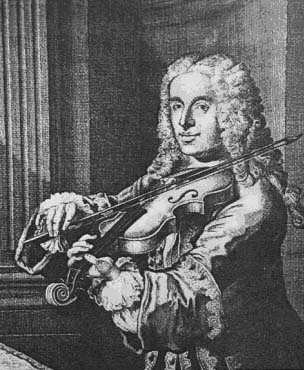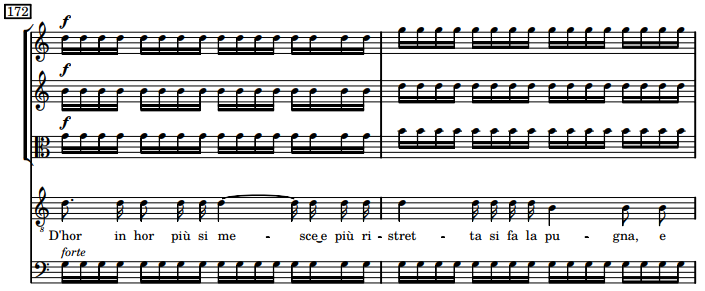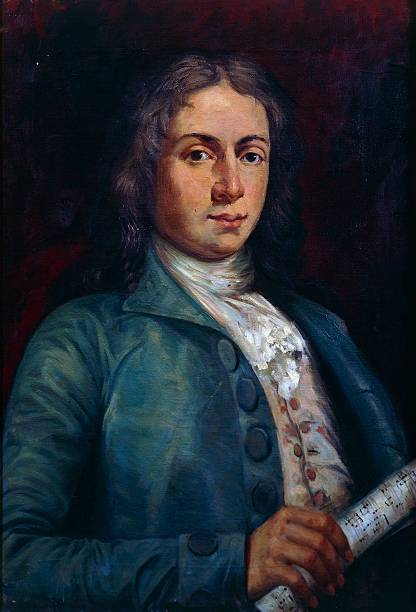|
Carlo Ambrogio Lonati
Carlo Ambrogio Lonati, baptized Giovanni Ambrogio Leinati, also Lunati; (c.1645 – c.1712) was an Italian composer, violinist and singer. Francesco Maria Veracini described him in 1760 as one of the most virtuoso violinists of his century. Life Nothing is known so far about the family and the musical education of Lonati, but he is thought to have been born in Milan. Between 1665 and 1667 he figured as a violinist in the viceroy's (Pedro Antonio de Aragón) chapel in Naples. Since 1673 he was in the service of Queen Christina of Sweden, and led her string orchestra, and from that time was also known as the "Queen's Hunchback" ('Il Gobbo della Regina'). He made friends with Alessandro Stradella, his companion in notoriety. Together with Carlo Mannelli and Lelio Colista he counted among the "più valorosi professori musici di Roma". From this period probably dates the majority of his compositions for several instruments. The Teatro Tordinona, the first public theater for ... [...More Info...] [...Related Items...] OR: [Wikipedia] [Google] [Baidu] |
Francesco Maria Veracini
Francesco Maria Veracini (1 February 1690 – 31 October 1768) was an Italian composer and violinist, perhaps best known for his sets of violin sonatas. As a composer, according to Manfred Bukofzer, "His individual, if not subjective, style has no precedent in baroque music and clearly heralds the end of the entire era", while Luigi Torchi maintained that "he rescued the imperiled music of the eighteenth century", His contemporary, Charles Burney, held that "he had certainly a great share of whim and caprice, but he built his freaks on a good foundation, being an excellent contrapuntist". The asteroid 10875 Veracini was named after him. Life Francesco Maria Veracini was born at about 8:00 a.m. on 1 February 1690 in the family house on the via Palazzuolo, parish of San Salvatore, Ognissanti, Florence. The second and only surviving son of Agostino Veracini, a pharmacist and undertaker (and ironically one of the few Veracinis who was not a violinist, even as an amateur) he w ... [...More Info...] [...Related Items...] OR: [Wikipedia] [Google] [Baidu] |
Giovanni Francesco Grossi
Giovanni Francesco Grossi (12 February 1653 – 29 May 1697) was one of the greatest Italian castrato singers of the baroque age. He is better known as Siface. Biography He was born near Pescia in Tuscany, entered the papal chapel in 1675, and later sang at Venice. He derived his nickname of Siface from his impersonation of that character in Cavalli's opera, ''Scipione affricano''. It has generally been said that he appeared as Siface in Alessandro Scarlatti's ''Mitridate'', but the confusion is due to his having sung the part of Mitridate in Scarlatti's ''Pompeo at Naples'' in 1683. In 1687, he was sent to London by the duke of Modena, to become a member of the chapel of James II. He probably did much for the introduction of Italian music into England, but soon left the country on account of the climate. He was murdered in 1697 on the road between Bologna and Ferrara, allegedly by the agents of a nobleman with whose wife he had a liaison, although later sources indicate that he ... [...More Info...] [...Related Items...] OR: [Wikipedia] [Google] [Baidu] |
Answers
Answer commonly refers to response to a question. Answer may also refer to: * Answer (law), any reply to a question, counter-statement or defense in a legal procedure Music * Answer, an element of a fugue Albums * ''Answer'' (Angela Aki album), 2009 * ''Answer'' (Supercar album), 2004 * ''Answers'' (album), 1994 * ''The Answers'', an album by Blue October Songs * "Answer" (Tohoshinki song) * "Answer" (Flow song), 2007 *"Answer", by Tyler, the Creator from the album ''Wolf'' *"Answer", by Sarah McLachlan from her 2003 album ''Afterglow'' *"Answer", by Mayu Maeshima, opening song from the 2021 anime ''Full Dive'' Publications * ''Answers'' (periodical), British weekly paper founded in 1888, initially titled ''Answers to Correspondents'' *''Answer'', a very short science-fiction story published in 1954 by Fredric Brown. *''Answers'', an American magazine published by Answers in Genesis * ''The Questionnaire'' (Salomon novel), also published as "The Answers" Groups, organiza ... [...More Info...] [...Related Items...] OR: [Wikipedia] [Google] [Baidu] |
Obbligato
In Western classical music, ''obbligato'' (, also spelled ''obligato'') usually describes a musical line that is in some way indispensable in performance. Its opposite is the marking ''ad libitum''. It can also be used, more specifically, to indicate that a passage of music was to be played exactly as written, or only by the specified instrument, without changes or omissions. The word is borrowed from Italian (an adjective meaning ''mandatory''; from Latin ''obligatus'' p.p. of ''obligare'', to oblige); the spelling ''obligato'' is not acceptable in British English, but it is often used as an alternative spelling in the US. The word can stand on its own, in English, as a noun, or appear as a modifier in a noun phrase (e.g. ''organ obbligato''). Independence ''Obbligato'' includes the idea of independence, as in C.P.E. Bach's 1780 Symphonies "''mit zwölf obligaten Stimmen''" ("with twelve ''obbligato'' parts") by which Bach was referring to the independent woodwind parts he was usi ... [...More Info...] [...Related Items...] OR: [Wikipedia] [Google] [Baidu] |
Stile Concitato
''Stile concitato'' (rather ''Genere concitato'') or "''agitated style''" is a Baroque style developed by Claudio Monteverdi with effects such as having rapid repeated notes and extended trills as symbols of bellicose agitation or anger. Kate Van Orden points out a precedent in Clément Janequin's "La Guerre" (1528). Agathe Sueur points out similarities and ambiguities between Monteverdi's ''genere concitato'' and ''stile concitato'' in rhetoric and poetry. Examples of ''stile concitato'' can be found in these works: *Monteverdi: ''Il Combattimento di Tancredi e Clorinda'' (written 1624) *Monteverdi: ''Il ritorno d'Ulisse in Patria'' (1639) *Monteverdi: ''L'incoronazione di Poppea'' (1642) *Giacomo Carissimi (1605–1674): ''Jephte'' * Barbara Strozzi (1619–1677): ''Tradimento'' History The earliest description of ''stile concitato'' comes from the foreword to ''Madrigali guerrieri, et amorosi'' ("Madrigals of war and love"), Claudio Monteverdi’s eighth and final book of mad ... [...More Info...] [...Related Items...] OR: [Wikipedia] [Google] [Baidu] |
Da Capo
Da capo (, also , ) is an Italian musical term that means "from the beginning" (literally, "from the head"). It is often abbreviated as D.C. The term is a directive to repeat the previous part of music, often used to save space, and thus is an easier way of saying to repeat the music from the beginning. In small pieces, this might be the same thing as a repeat. But in larger works, D.C. might occur after one or more repeats of small sections, indicating a return to the very beginning. The resulting structure of the piece is generally in ternary form. Sometimes, the composer describes the part to be repeated, for example: ''Menuet da capo''. In opera, where an aria of this structure is called a ''da capo aria'', the repeated section is often adorned with grace notes. The word ''Fine'' (Ital. 'end') is generally placed above the stave at the point where the movement ceases after a 'Da capo' repetition. Its place is occasionally taken by a pause (see fermata)."Grove, George; Ful ... [...More Info...] [...Related Items...] OR: [Wikipedia] [Google] [Baidu] |
Alessandro Scarlatti
Pietro Alessandro Gaspare Scarlatti (2 May 1660 – 22 October 1725) was an Italian Baroque composer, known especially for his operas and chamber cantatas. He is considered the most important representative of the Neapolitan school of opera. Nicknamed by his contemporaries "the Italian Orpheus", he divided his career between Naples and Rome, where he received his training; a significant part of his works was composed for the papal city. He is often considered the founder of the Neapolitan school, although he has only been its most illustrious representative: his contribution, his originality and his influence were essential, as well as lasting, both in Italy and in Europe. Particularly known for his operas, he brought the Italian dramatic tradition to its maximum development, begun by Monteverdi at the beginning of 17th century and continued by Cesti, Cavalli, Carissimi, Legrenzi and Stradella, designing the final form of the ''Da capo aria'', imitated throughout Europe. H ... [...More Info...] [...Related Items...] OR: [Wikipedia] [Google] [Baidu] |
Cantata
A cantata (; ; literally "sung", past participle feminine singular of the Italian verb ''cantare'', "to sing") is a vocal composition with an instrumental accompaniment, typically in several movements, often involving a choir. The meaning of the term changed over time, from the simple single-voice madrigal of the early 17th century, to the multi-voice "cantata da camera" and the "cantata da chiesa" of the later part of that century, from the more substantial dramatic forms of the 18th century to the usually sacred-texted 19th-century cantata, which was effectively a type of short oratorio. Cantatas for use in the liturgy of church services are called church cantata or sacred cantata; other cantatas can be indicated as secular cantatas. Several cantatas were, and still are, written for special occasions, such as Christmas cantatas. Christoph Graupner, Georg Philipp Telemann and Johann Sebastian Bach composed cycles of church cantatas for the occasions of the liturgical year. ... [...More Info...] [...Related Items...] OR: [Wikipedia] [Google] [Baidu] |
Idiosyncratic
An idiosyncrasy is an unusual feature of a person (though there are also other uses, see below). It can also mean an odd habit. The term is often used to express eccentricity or peculiarity. A synonym may be "quirk". Etymology The term "idiosyncrasy" originates from Greek ', "a peculiar temperament, habit of body" (from ', "one's own", ', "with" and ', "blend of the four humors" (temperament)) or literally "particular mingling". Linguistics The term can also be applied to symbols or words. ''Idiosyncratic symbols'' mean one thing for a particular person, as a blade could mean war, but to someone else, it could symbolize a surgery. Idiosyncratic property In phonology, an ''idiosyncratic property'' contrasts with a ''systematic regularity''. While systematic regularities in the sound system of a language are useful for identifying phonological rules during analysis of the forms morphemes can take, idiosyncratic properties are those whose occurrence is not determined by those rul ... [...More Info...] [...Related Items...] OR: [Wikipedia] [Google] [Baidu] |
Scordatura
Scordatura (; literally, Italian for "discord", or "mistuning") is a tuning of a string instrument that is different from the normal, standard tuning. It typically attempts to allow special effects or unusual chords or timbre, or to make certain passages easier to play. It is common to notate the finger position as if played in regular tuning, while the actual pitch resulting is altered (scordatura notation). When all the strings are tuned by the same interval up or down, as in the case of the viola in Mozart's ''Sinfonia Concertante for Violin, Viola and Orchestra'', the part is transposed as a whole. Bowed string instruments The invention of scordatura tuning has been attributed to Thomas Baltzar, a prodigious German violinist and composer who is known to have used the technique in around the 1660s, at least a decade before Biber composed his ''Rosary Sonatas'' in which he employed the tuning technique. Of course, German violinist Hans Hake (1628 – after 1667) includes three ... [...More Info...] [...Related Items...] OR: [Wikipedia] [Google] [Baidu] |
Johann Georg Pisendel
Johann Georg Pisendel ( – 25 November 1755) was a German Baroque violinist and composer who, for many years, led the Court Orchestra in Dresden as concertmaster, then the finest instrumental ensemble in Europe. He was the leading violinist of his time, and composers such as Tomaso Albinoni, Georg Philipp Telemann and Antonio Vivaldi all dedicated violin compositions to him. Life Pisendel was born in Cadolzburg, a small town near Nuremberg, where his father Simon Pisendel was the cantor and organist. At the age of nine, Johann Georg became a choirboy at the court chapel of Ansbach, where the singer Francesco Antonio Pistocchi was music director, and violinist and composer Giuseppe Torelli was concert master. It is thought that Pisendel studied the violin with Torelli. After his voice broke, Pisendel went on to play the violin in the Court Orchestra. In 1709, he left Dresden for Leipzig to further his musical studies. On the way to Leipzig, he met Johann Sebastian Bach at Weim ... [...More Info...] [...Related Items...] OR: [Wikipedia] [Google] [Baidu] |
Basso Continuo
Basso continuo parts, almost universal in the Baroque era (1600–1750), provided the harmonic structure of the music by supplying a bassline and a chord progression. The phrase is often shortened to continuo, and the instrumentalists playing the continuo part are called the ''continuo group''. Forces The composition of the continuo group is often left to the discretion of the performers (or, for a large performance, the conductor), and practice varied enormously within the Baroque period. At least one instrument capable of playing chords must be included, such as a harpsichord, organ, lute, theorbo, guitar, regal, or harp. In addition, any number of instruments that play in the bass register may be included, such as cello, double bass, bass viol, or bassoon. In modern performances of chamber works, the most common combination is harpsichord and cello for instrumental works and secular vocal works, such as operas, and organ and cello for sacred music. A double bass may ... [...More Info...] [...Related Items...] OR: [Wikipedia] [Google] [Baidu] |




